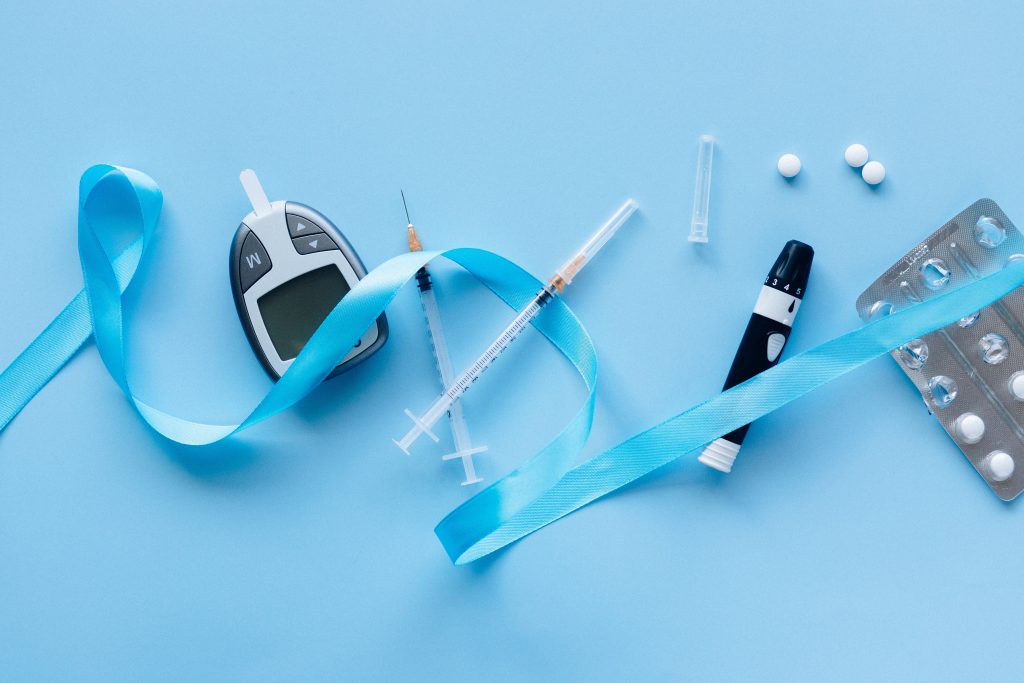

November is American Diabetes Month. Let’s get up to speed on this common disorder.
Diabetes is a chronic metabolic condition that affects how your body uses food for energy. When you eat, your body breaks down the food into a simple sugar called glucose, which enters your body’s cells with the help of insulin, a hormone produced by special beta cells in your pancreas. When the amount of glucose in your blood increases, it signals the pancreas to release insulin.
With diabetes, either your pancreas doesn’t make enough insulin or your body stops responding to the insulin made, a condition called insulin resistance. When this occurs, too much glucose accumulates in your blood, called hyperglycemia. Untreated hyperglycemia can lead to serious health problems, such as heart disease, kidney disease, nerve damage and vision loss.
According to the Centers for Disease Control and Prevention, 34.2 million US adults have diabetes, and one in five don’t know they have it. Diabetes is the seventh leading cause of death in the US and the number one cause of kidney failure, lower limb amputations and adult blindness. The number of adults diagnosed with diabetes has more than doubled in the last 20 years.
There are three main types of diabetes: Type 1, Type 2 and gestational. Type 1 diabetes is an autoimmune disease. It occurs when your immune system mistakenly attacks and destroys the beta cells in your pancreas, so no insulin gets produced. The reason for the attack is not known, but genetics may play a role. It’s also possible that a virus sets off the immune system’s attack.
Type 1 diabetes is most often diagnosed in children and teens but can occur at any age. People with this type of diabetes must take insulin every day to stay alive.
Type 2 diabetes occurs when your body develops insulin resistance and glucose builds up in your blood. It’s the most common type of diabetes, accounting for 90 to 95 percent of diabetes cases. You can develop Type 2 diabetes at any age but it’s most often diagnosed in people ages 45 and older. A combination of genetics and lifestyle factors are believed to cause this type of diabetes.
You are at a greater risk for developing Type 2 diabetes if you are overweight; have a family history of diabetes; have a family history of high blood pressure; have had gestational diabetes or gave birth to a baby weighing more than 9 pounds; are African-American, Native-American, Latin-American or Asian-Pacific Islander or live a sedentary lifestyle.
In many cases, Type 2 diabetes can be managed by controlling your weight, exercising regularly and eating a healthy diet high in whole grains, fruits, vegetables and lean proteins. Sometimes, people with Type 2 diabetes must take medication or inject insulin to control their blood glucose levels.
Gestational diabetes occurs in women who are pregnant and usually resolves after they give birth. It develops when the placenta produces hormones that make your cells less sensitive to the effects of insulin. If you have gestational diabetes, your baby is at a higher risk for health problems, such as excessive birth weight, early (preterm) birth, breathing problems, low blood glucose (hypoglycemia) and even stillbirth.
Further, you and your baby are at a greater risk for developing Type 2 diabetes later in life.
Treatment for gestational diabetes typically includes special meal plans and scheduled physical activity. You may have to inject insulin if you cannot manage your glucose level with diet and exercise alone.
If you have any type of diabetes, it’s important that you check your blood glucose level frequently throughout the day.
Prediabetes is a condition in which your blood glucose level is elevated but not high enough to warrant a diagnosis of Type 2 diabetes. In the US, 88 million adults, more than one in three, have prediabetes, and 84 percent of them don’t know they have it. Having prediabetes raises your risk for developing Type 2 diabetes, heart disease and stroke.
Each type of diabetes has its own symptoms, but there are some general symptoms. These include increased hunger, increased thirst, weight loss, frequent urination, blurry vision, extreme fatigue and sores that don’t heal.
There are certain blood tests your doctor will use to make a diagnosis of prediabetes and diabetes. The fasting plasma glucose test measures your blood glucose after you’ve not eaten anything for eight hours. The A1c test provides a view of your blood glucose levels over the previous three months.
The glucose challenge test checks your blood glucose level an hour after you drink a sugary liquid, and the glucose tolerance test checks your glucose level after you fast overnight and then drink a sugary liquid.
Women who are pregnant are typically tested for gestational diabetes between the 24th and 28th weeks of their pregnancy.
If you eat a healthy diet, control your weight, exercise regularly and follow your doctor’s instructions for taking any medications, if required, you can successfully manage your diabetes and live a full and active life.





Leave a Reply